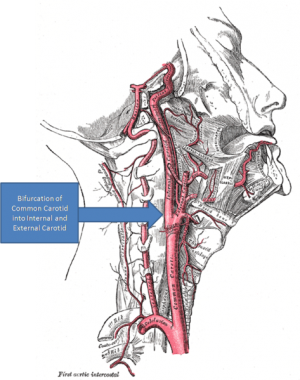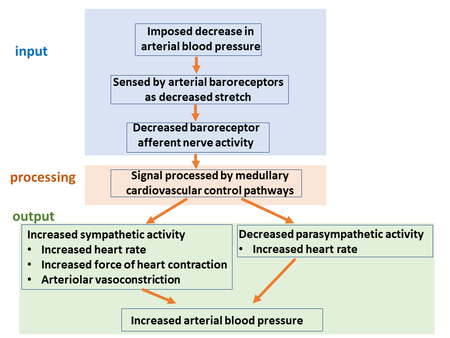Baroreceptors: Difference between revisions
No edit summary |
No edit summary |
||
| Line 5: | Line 5: | ||
</div> | </div> | ||
== Introduction == | == Introduction == | ||
Baroreceptors are a type of mechanoreceptor allowing for the relay of information derived from [[Blood Pressure|blood pressure]] within the autonomic nervous system. Information is then passed in rapid sequence to alter the total peripheral resistance and cardiac output maintaining blood pressure within a preset, normalized range. | [[File:473px-Gray's Anatomy with markup showing carotid artery bifurcation.png|right|frameless]] | ||
Baroreceptors are a type of mechanoreceptor allowing for the relay of information derived from [[Blood Pressure|blood pressure]] within the autonomic nervous system. | |||
* They are spray-type nerve endings in the walls of blood vessels and the heart that are stimulated by the absolute level of, and changes in, arterial pressure. They are extremely abundant in the wall of the bifurcation of the internal carotid arteries (carotid sinus) and in the wall of the aortic arch<ref name=":0">Kass JS, Mizrahi EM. [https://www.sciencedirect.com/topics/biochemistry-genetics-and-molecular-biology/baroreceptor Neurology secrets] e-book. Elsevier Health Sciences; 2010 Apr 30.Available from: https://www.sciencedirect.com/topics/biochemistry-genetics-and-molecular-biology/baroreceptor (accessed 26.2.2021)</ref>. | |||
The primary site of termination of baroreceptor afferent fibers is the nucleus tractus solitarius (NTS). Information is then passed in rapid sequence to alter the total peripheral resistance and cardiac output maintaining blood pressure within a preset, normalized range. | |||
There are two types of baroreceptors: | There are two types of baroreceptors: | ||
| Line 11: | Line 14: | ||
# Low-pressure volume receptors, or cardiopulmonary receptors, are located within the atria, ventricles, and pulmonary vasculature<ref>Armstrong M, Moore RA. [https://www.statpearls.com/articlelibrary/viewarticle/18138/ Physiology, Baroreceptors.] StatPearls [Internet]. 2020 Mar 23.Available from:https://www.statpearls.com/articlelibrary/viewarticle/18138/ (accessed 26.2.2021)</ref> | # Low-pressure volume receptors, or cardiopulmonary receptors, are located within the atria, ventricles, and pulmonary vasculature<ref>Armstrong M, Moore RA. [https://www.statpearls.com/articlelibrary/viewarticle/18138/ Physiology, Baroreceptors.] StatPearls [Internet]. 2020 Mar 23.Available from:https://www.statpearls.com/articlelibrary/viewarticle/18138/ (accessed 26.2.2021)</ref> | ||
== | == Function == | ||
[[File:Baroreceptor reflex block diagram.png|right|frameless|450x450px]] | |||
The function of the baroreceptors is to maintain systemic blood pressure at a relatively constant level, especially during a change in body position. Intact baroreceptors are extremely effective in preventing rapid changes in blood pressure from moment to moment or hour to hour, but because of their adaptability to prolonged changes of blood pressure (> 2 or 3 days), the system is incapable of long-term regulation of arterial pressure. | |||
* Stretching of the baroreceptors as a result of increased blood pressure causes an increase in the activity of the vagal nerve by projection to the nucleus ambiguus. It also causes inhibition of the sympathetic outflow from the RVLM, ultimately leading to decreased heart rate and blood pressure. | |||
* Conversely, decreased blood pressure results in decreased signal output from the baroreceptors, leading to disinhibition of the central sympathetic control sites and decreased parasympathetic activity. The final effect is an increase in blood pressure.<ref name=":0" /> | |||
== Sub Heading 3 == | == Sub Heading 3 == | ||
Revision as of 07:57, 26 February 2021
Original Editor - Lucinda hampton
Top Contributors - Lucinda hampton
Introduction[edit | edit source]
Baroreceptors are a type of mechanoreceptor allowing for the relay of information derived from blood pressure within the autonomic nervous system.
- They are spray-type nerve endings in the walls of blood vessels and the heart that are stimulated by the absolute level of, and changes in, arterial pressure. They are extremely abundant in the wall of the bifurcation of the internal carotid arteries (carotid sinus) and in the wall of the aortic arch[1].
The primary site of termination of baroreceptor afferent fibers is the nucleus tractus solitarius (NTS). Information is then passed in rapid sequence to alter the total peripheral resistance and cardiac output maintaining blood pressure within a preset, normalized range.
There are two types of baroreceptors:
- High-pressure arterial baroreceptors and low-pressure volume receptors which are both stimulated by stretching of the vessel wall. Arterial baroreceptors are located within the carotid sinuses and the aortic arch.
- Low-pressure volume receptors, or cardiopulmonary receptors, are located within the atria, ventricles, and pulmonary vasculature[2]
Function[edit | edit source]
The function of the baroreceptors is to maintain systemic blood pressure at a relatively constant level, especially during a change in body position. Intact baroreceptors are extremely effective in preventing rapid changes in blood pressure from moment to moment or hour to hour, but because of their adaptability to prolonged changes of blood pressure (> 2 or 3 days), the system is incapable of long-term regulation of arterial pressure.
- Stretching of the baroreceptors as a result of increased blood pressure causes an increase in the activity of the vagal nerve by projection to the nucleus ambiguus. It also causes inhibition of the sympathetic outflow from the RVLM, ultimately leading to decreased heart rate and blood pressure.
- Conversely, decreased blood pressure results in decreased signal output from the baroreceptors, leading to disinhibition of the central sympathetic control sites and decreased parasympathetic activity. The final effect is an increase in blood pressure.[1]
Sub Heading 3[edit | edit source]
Resources[edit | edit source]
- bulleted list
- x
or
- numbered list
- x
References[edit | edit source]
- ↑ 1.0 1.1 Kass JS, Mizrahi EM. Neurology secrets e-book. Elsevier Health Sciences; 2010 Apr 30.Available from: https://www.sciencedirect.com/topics/biochemistry-genetics-and-molecular-biology/baroreceptor (accessed 26.2.2021)
- ↑ Armstrong M, Moore RA. Physiology, Baroreceptors. StatPearls [Internet]. 2020 Mar 23.Available from:https://www.statpearls.com/articlelibrary/viewarticle/18138/ (accessed 26.2.2021)








